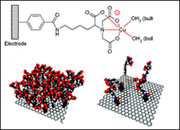Publication
638
J. Phys. Chem. B
112, 14221-14229, 2008.
DOI:
10.1021/jp8028825
|
|
|
|
|
 |
Molecular Dynamics Description of Grafted Monolayers: Effect of the Surface Coverage. |
|
|
|
|
|
F. Goujon, C. Bonal, B. Limoges and P. Malfrey
Laboratoire de Thermodynamique et Interactions Moléculaires de l'Université Blaise Pascal (Clermont-Ferrand II), FRE 3099, 24 Avenue des Landais, 63177 Aubière Cedex, and Laboratoire d'Electrochimie Moléculaire de l'Université Denis Diderot (Paris 7), UMR CNRS 7591, 2 Place Jussieu, 75251 Paris Cedex 05, France
Molecular dynamics simulations of monolayers of metal-chelating ligands grafted onto a graphite surface in water are carried out to calculate structural (density profiles, radius of gyration, and asphericity coefficients), dynamical (diffusion coefficients), and energetical properties as a function of the surface coverage. The purpose is to provide a better understanding of the dependence of various properties of these monolayers on the surface coverage. A critical value of the surface coverage from which all structural properties derive a limiting value has been established. It also appears that the chains rather adopt an elongated conformation along the direction normal to the surface from this critical surface coverage. The hydrogen-bonding structure and dynamics of water molecules are reported. An ordered structure of water in the region close to the terminal groups of the grafted molecules is shown at a relatively high surface coverage. This ordering is similar to that observed in the case of water in interaction with a solid surface. |

